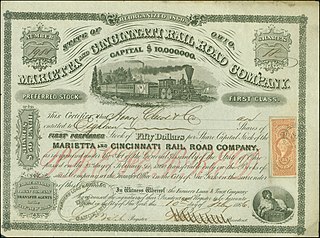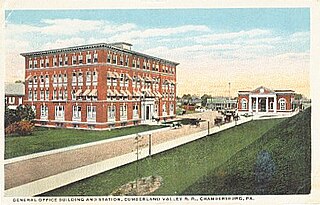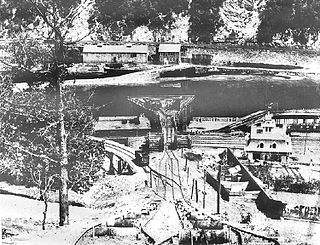
A railway zig zag or switchback, is a method of climbing steep gradients with minimal need for tunnels and heavy earthworks. For a short distance, the direction of travel is reversed, before the original direction is resumed. Not all switchbacks come in pairs, in which case the train may need to travel backwards for a considerable distance.

The Marietta and Cincinnati (M&C) was one of five important east-west railroads of southern Ohio; it was later absorbed by the Baltimore and Ohio Railroad (B&O). Its original route ran from Marietta through Vincent, Athens, Hamden, Chillicothe, Greenfield, Blanchester, and Loveland. It had two main branches: Blanchester to Hillsboro, which was originally part of the Hillsboro and Cincinnati Railroad; and Hamden to Portsmouth, Ohio, originally part of the Scioto and Hocking Valley Railroad.
The Clinchfield Railroad was an operating and holding company for the Carolina, Clinchfield and Ohio Railway. The line ran from the coalfields of Virginia and Elkhorn City, Kentucky, to the textile mills of South Carolina. The 35-mile segment from Dante, Virginia, to Elkhorn City, opening up the coal lands north of Sandy Ridge Mountains and forming a connection with the Chesapeake and Ohio Railway at Elkhorn City, was completed in 1915.

This is a list of the earliest railroads in North America, including various railroad-like precursors to the general modern form of a company or government agency operating locomotive-drawn trains on metal tracks.

The Roaring Camp & Big Trees Narrow Gauge Railroad is a 3 ft narrow-gauge tourist railroad in California that starts from the Roaring Camp depot in Felton, California and runs up steep grades through redwood forests to the top of nearby Bear Mountain, a distance of 3 1⁄4 miles (5.2 km).

The Lake Superior and Ishpeming Railroad, a U.S. railroad offering service from Marquette, Michigan, to nearby locations in Michigan's Upper Peninsula, began operations in 1896. The LS&I continues to operate as an independent railroad from its headquarters in Marquette.
The Bellefonte Central Railroad was a shortline connecting Bellefonte and State College, Pennsylvania. Constructed in the late 19th century to haul local iron ore to furnaces in the Bellefonte region, it later hauled freight traffic to Penn State and lime for steelmaking from local quarries. The line to State College was abandoned in 1974, and most of the remaining railroad in 1984, but a small portion is still used by the Nittany and Bald Eagle Railroad.

State Route 16 is a primary state highway in the southwest part of the U.S. state of Virginia. It runs from the North Carolina border at North Carolina Highway 16 north to the West Virginia border at West Virginia Route 16, passing through the towns of Troutdale, Marion, and Tazewell. Highway 16 is part of a three-state route 16 that connects the Charlotte region with northwestern West Virginia.
The Lebanon and Tremont Branch of the Philadelphia & Reading Railroad was a railroad line in Lebanon and Schuylkill County, Pennsylvania, built to tap the coal fields in the West End of Schuylkill County and send coal southward to Lebanon.

The Bellefonte and Snow Shoe Railroad was a coal-hauling railroad in Centre County, Pennsylvania. Begun in 1859, it came under the control of the Pennsylvania Railroad in 1881. Closing of mines in the 1930s resulted in the decline of traffic on the railroad, which was abandoned in 1959.

The Cumberland Valley Railroad was an early railroad in Pennsylvania, United States, originally chartered in 1831 to connect with Pennsylvania's Main Line of Public Works. Freight and passenger service in the Cumberland Valley in south central Pennsylvania from near Harrisburg to Chambersburg began in 1837, with service later extended to Hagerstown, Maryland and then extending into the Shenandoah Valley to Winchester, Virginia. It employed up to 1,800 workers.

The Mauch Chunk and Summit Railroad was a coal-hauling railroad in the mountains of Pennsylvania that operated between 1828 and 1932. It was the first operational US railway of any substantial length to carry paying passengers.

The Hocking Valley Railway was a railroad in the U.S. state of Ohio, with a main line from Toledo to Athens and Pomeroy via Columbus. It also had several branches to the coal mines of the Hocking Valley near Athens. The company became part of the Chesapeake and Ohio Railway system in 1910, and the line between Toledo and Columbus continues to see trains as CSX Transportation's Columbus Subdivision. Portions of the main line south of Columbus are now operated by the Indiana and Ohio Railway and Hocking Valley Scenic Railway.

The Buffalo and Susquehanna Railroad was a railroad company that formerly operated in western and north central Pennsylvania and western New York. It was created in 1893 by the merger and consolidation of several smaller logging railroads. It operated independently until 1929, when a majority of its capital stock was purchased by the Baltimore and Ohio Railroad. At the same time, the B&O also purchased control of the neighboring Buffalo, Rochester, and Pittsburgh Railway. The Baltimore and Ohio officially took over operations of both roads in 1932.
The Greenbrier, Cheat and Elk Railroad (GC&E) was a logging railroad in West Virginia operating in the early 20th century. Its main line ran from Bergoo to Cheat Junction, where it connected with the Western Maryland Railway (WM).

The Bachman Valley Railroad (BV) was a railroad that operated in Pennsylvania and Maryland, United States, in the 19th century. The 13 mile (21 km) line ran from Valley Junction, Pennsylvania to Ebbvale, Maryland. The railroad was built to transport iron ore to local blast furnaces; it also carried some passengers. The railroad became part of the Western Maryland Railway in 1917.

The South Mountain Railroad was a southcentral Pennsylvania railway line for "connecting the Pine Grove works to the Cumberland Valley R. R." and which provided mining and passenger services via a southwest section from Hunter's Run, Pennsylvania, and a northern section from Hunter's Run to the CVRR junction northeast of Carlisle. The northern section merged with the Gettysburg & Harrisburg Railroad line south from Hunter's Run to the Gettysburg Battlefield in 1891 to create the Gettysburg & Harrisburg Railway line, while the branch southwest from Hunter's Run became the Hunter's Run and Slate Belt Railroad line.

The Potomac, Fredericksburg, and Piedmont Railroad (PF&P) was a 3 ft narrow gauge short-line railroad in central Virginia that operated between Fredericksburg and Orange, Virginia. It operated until 1926, when its track was sold. A one-mile portion of the former PF&P line continued to be operated as the Virginia Central Railway until the early 1980s. The track has since been removed.

The Valley Railway was a shortline railroad which operated between the city of Cleveland and small town of Zoarville in the state of Ohio in the United States. The railroad was founded in 1871, but the first segment of track did not open until 1880 and the line was not completed until 1884. The Baltimore and Ohio Railroad (B&O) obtained a controlling interest in the Valley Railway in 1890. The railroad went bankrupt in 1895, at which time it was reorganized as the Cleveland, Terminal and Valley Railway (CT&V). The B&O took over operation of the CT&V in 1909, and the company was merged with the B&O in 1915.














